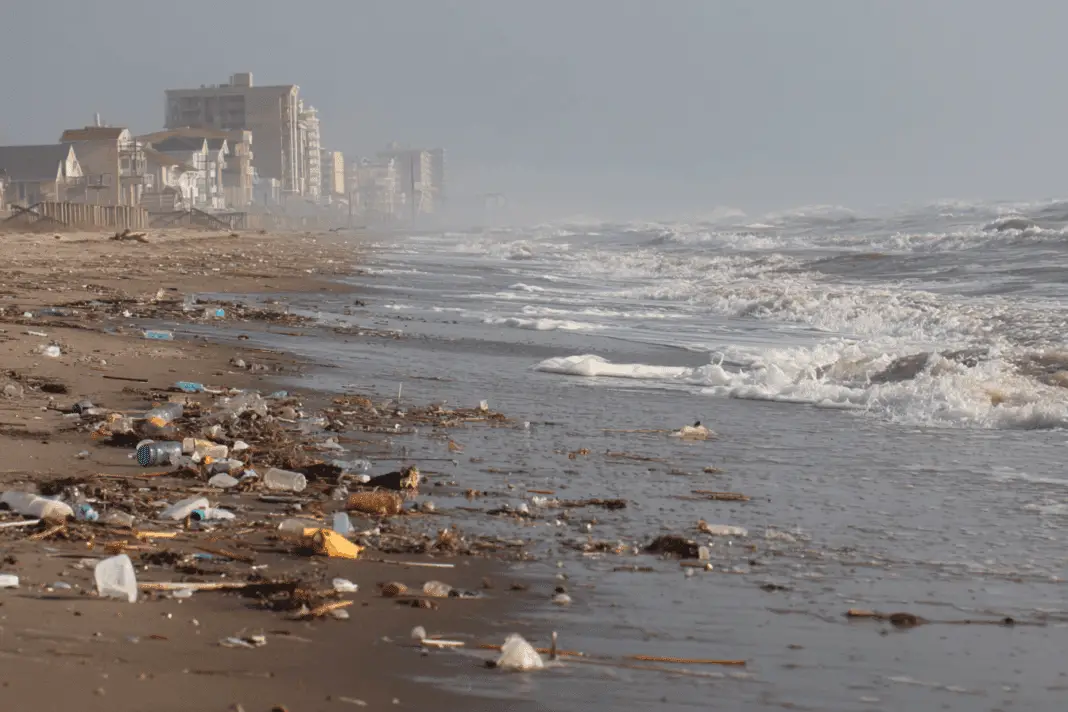Swimming at the beach should be refreshing and fun, not a gamble with your health. While millions of Americans flock to coastal destinations each summer, many popular beaches across the country are battling serious contamination issues that would make most people think twice about taking a dip. From raw sewage overflows to stormwater runoff carrying everything from pet waste to industrial chemicals, these supposedly pristine shorelines hide some pretty nasty secrets beneath their waves.
Texas beaches top contamination charts annually
Cole Park Beach in Corpus Christi consistently ranks as one of the most bacteria-laden swimming spots in Texas. This popular family destination features playgrounds, skate parks, and amphitheaters alongside stunning city skyline views, making it a go-to spot for locals and tourists alike. However, the same infrastructure that makes the area attractive also contributes to its pollution problems. When heavy rains overwhelm the city’s aging sewer systems, raw sewage flows directly into streets, creeks, and eventually into Corpus Christi Bay.
Environment America’s 2022 assessment found Cole Park had more unsafe swimming days than any other Texas beach that year. Neighboring recreation areas like Ropes Park and Poenisch Park followed closely behind, suggesting this is a regional problem rather than an isolated incident. Despite ongoing community improvement projects overseen by the Texas Commission on Environmental Quality, similar cleanup efforts have been attempted since 2012 with limited success, leaving beachgoers to wonder when real solutions will arrive.
Rhode Island’s historic beach struggles with bacteria
Easton’s Beach in Newport has welcomed swimmers since the 1800s, when America’s wealthiest families built their Gilded Age mansions along this prestigious coastline. Today, those same families would likely choose different swimming spots. Recent water quality testing revealed this historic beach was unsafe for swimming more frequently than any other Rhode Island coastline, with dangerous bacteria levels appearing regularly throughout the swimming season. The contamination stems from Easton’s Stream, which connects the beach to a nearby freshwater pond used as a drinking water source.
Storm activity makes the situation even worse, creating a vicious cycle of contamination. When rough seas hit the coast, bacteria-laden ocean spray gets blown back toward shore and into the freshwater pond, while stormwater runoff carries additional pollutants from the surrounding community. Testing data from 2022 showed that 30% of water samples exceeded safe levels for recreational swimming, with some readings reaching over 300 colony-forming units per 100 milliliters – five times the EPA’s safety threshold.
Hamptons wealth can’t buy clean water
Flying Point Beach in Southampton proves that even the most exclusive zip codes aren’t immune to water contamination issues. This Hamptons hotspot, surrounded by multi-million-dollar estates, recorded the highest bacteria levels along New York’s entire coastline according to recent water quality reports. The irony is hard to miss – some of America’s wealthiest residents pay premium prices for beachfront property, only to deal with sewage-tainted swimming conditions right outside their back doors.
The root of Flying Point’s problems lies in stagnant Mecox Bay, located just inland from the beach. This enclosed waterway collects stormwater runoff from the surrounding community, which frequently contains contamination from the old septic systems and cesspools that much of the Hamptons still relies on. To prevent bacteria levels from spiraling completely out of control, local officials periodically dig temporary canals between the bay and the Atlantic Ocean, effectively flushing the polluted water directly onto the beach where people swim and surf.
Maine’s wildlife haven harbors dangerous pathogens
Goose Rocks Beach in Kennebunkport offers postcard-perfect scenery with white sand, nearby islands, and playful harbor seals that delight visitors year-round. This natural beauty masks a serious contamination problem that earned the beach Maine’s most polluted coastline designation in recent environmental assessments. Two tidal waterways – Batson River and Little River – flow directly onto the beach carrying dangerous levels of enterococci bacteria and other harmful microorganisms that pose health risks to swimmers.
The contamination is so persistent that Kennebunkport officials installed permanent warning signs advising people to stay out of these polluted streams. While the main swimming area isn’t considered particularly dangerous under normal conditions, heavy rainfall and powerful tides can quickly spread contamination throughout the beach area. Environmental testing consistently shows unhealthy levels of pathogens in both rivers, making this scenic beach a gamble for anyone hoping to cool off in the water during hot summer days.
Mississippi’s short coastline faces widespread contamination
Mississippi’s coastline stretches only 70 miles, but finding safe swimming spots along those beaches is becoming increasingly difficult. Gulfport West Beach exemplifies this growing problem, with state environmental officials issuing bacterial contamination advisories in early 2025. The same beach appeared on national lists of the most polluted shores, indicating this isn’t a temporary issue but rather an ongoing public health concern affecting one of the state’s primary tourist attractions.
The contamination problem is spreading beyond Gulfport to other Mississippi beaches including Bay St. Louis, Pass Christian, and Long Beach. Recent testing suggests bacteria from wastewater treatment plants, failing septic systems, and recreational boat sewage are all contributing to dangerous water conditions. Health advisories warn that swimmers face higher illness risks, especially following heavy rainfall when runoff carries additional contaminants into coastal waters, effectively limiting safe beach activities along much of the state’s already limited shoreline.
California border creates international pollution crisis
Imperial Beach near San Diego faces a unique contamination challenge that crosses international borders and involves federal agencies. This oceanfront community boasts excellent surf breaks and a scenic wooden pier, but it also sits directly north of the Tijuana River, which regularly carries untreated sewage from Mexico into California waters. The situation has become so severe that the entire beach remains closed as of early 2025, with no clear timeline for reopening to recreational activities.
The federally managed South Bay International Wastewater Treatment Plant, built in the 1990s, simply cannot handle the volume of pollution flowing north from Mexico. Recent water quality testing showed that 100% of samples taken at Imperial Beach failed to meet state health standards for recreational swimming. This ongoing environmental emergency has turned what should be a premier California beach destination into a cautionary tale about cross-border pollution and inadequate infrastructure, leaving residents and visitors with limited options for safe ocean activities.
Hawaii paradise deals with persistent bacterial issues
Kalapaki Beach Park on Kauai seems like an ideal tropical destination, located less than a mile from Lihue Airport with a towering resort and impressive pool facilities nearby. The convenience and amenities make this beach attractive to tourists, but the water quality tells a different story. Officials have issued multiple bacterial contamination notifications here, with the most recent warning coming in early January 2025, continuing a pattern of pollution advisories that have plagued this location for years.
Water quality testing in 2023 revealed the extent of the problem at Kalapaki Beach Park. Every single water sample taken from the stream leading to the beach exceeded allowable bacterial contamination levels for Hawaii’s recreational areas. This 100% failure rate suggests systemic contamination issues rather than occasional pollution events, making the nearby resort pool a much safer option for visitors who want to enjoy water activities during their Hawaiian vacation.
Massachusetts historic town struggles with century-old problems
King’s Beach in Swampscott has attracted families since the late 1800s, when this quaint Massachusetts coastal town first became a popular summer destination. While the community’s historic houses remain beautifully preserved, the main attraction hasn’t aged as gracefully. King’s Beach earned the distinction of being Massachusetts’ most contaminated oceanfront location in both 2020 and 2022, with pollution levels that would shock visitors expecting pristine New England coastal conditions.
The contamination stems from infrastructure decisions made about a century ago, when a neighborhood brook was modified to channel both sewage and stormwater directly onto the beach. Although those drainage systems have since been separated, untreated human waste still finds its way to the ocean here. Some locals have become resigned to the situation – when asked about the bacterial contamination, one beachgoer simply replied that “the bacteria has always been here,” suggesting this historic beach’s reputation for pollution has become an accepted part of the community’s identity.
California surf spot battles urban runoff contamination
Linda Mar Beach in Pacifica remains popular among surfers, sunbathers, and dog owners despite earning failing grades from California water quality monitoring organizations. This state beach allows leashed dogs, making it particularly attractive to pet owners, but the presence of animals may contribute to the high bacterial levels found in water testing. Urban runoff flowing through San Pedro Creek carries contamination directly into the ocean at this location, creating persistent pollution problems that don’t deter the beach’s loyal following.
Local environmental groups identify multiple sources contributing to Linda Mar’s contamination issues, including animal waste, failing sewage infrastructure, and the polluted condition of San Pedro Creek itself. The Pacific Beach Coalition emphasizes that improving water quality requires community-wide efforts to keep sidewalks, gutters, yards, and streets clean, since all of this debris eventually flows into the creek and onto the beach. Recent assessments show that addressing urban runoff pollution remains one of California’s biggest challenges for maintaining safe recreational beaches along its extensive coastline.
These contaminated beaches represent a nationwide problem that affects millions of Americans seeking safe recreational swimming opportunities. From aging infrastructure and stormwater runoff to international sewage flows and industrial pollution, the sources of beach contamination are as varied as they are persistent, reminding us that even our most beloved coastal destinations require ongoing vigilance and investment to remain safe for public enjoyment.

